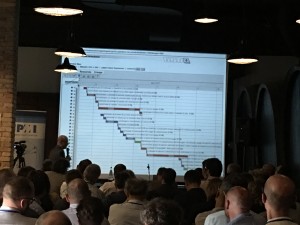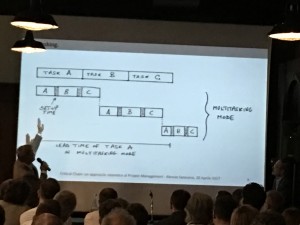This post is by Dr. Domenico Lepore, Founder of Intelligent Management.
A few days ago I had the opportunity to present the ideas that we at Intelligent Management promote on both sides of the “pond” to an extremely qualified and attentive audience: The Northern Italian Chapter of the PMI Institute. The venue, a very well-known winery in the Trentino Province, provided an idyllic backdrop to the event.
Although not always in agreement with the Curriculum PMI proposes to its members, I fully acknowledge their endeavours to promote good practices in Project Management. In this spirit, I gladly accepted their invitation to talk about “New Leadership for Complexity”.
New Leadership for Complexity
The focus of the presentation was on the fallacies of “linear thinking” and the new organizational paradigm that stems from understanding complexity, i.e. the essence of the work of any organization is the multitude of projects that moves it toward its goal. It is only reasonable to envisage an organizational design that mirrors this simple reality. This new design is “the network of projects” that almost naturally emerges from understanding the monumental work of W. Edwards Deming and Eliyahu M. Goldratt (Theory of Constraints).
My friends and colleagues Giovanni Siepe and Alessio Saraceno (COO of Hyphen Italia) brilliantly added to my sermon an extremely incisive and thorough elucidation on the how’s and why’s of the Critical Chain approach to managing projects.
At the end, among all the questions, one in particular gave me the possibility to re-affirm Intelligent Management’s views on the path to organizational transformation from Hierarchy to System that needs to take place in this age of complexity.
The question was (a stroke of luck for me):
“What do you make of the PMO (Project Management Office)?”
Here we go:
Definition of PMO (from Wikipedia): A project management office, abbreviated to PMO, is a group or department within a business, agency or enterprise that defines and maintains standards for project management within the organization. The PMO strives to standardize and introduce economies of repetition in the execution of projects
My answer:
“PMO is another silo, constantly fighting for its local optimum. PMO is the offspring of a half-baked view of the role that projects play in the life of an organization.”
(See Digital and Decentralized or How to Embrace Complexity)
The way ahead: beyond the PMO
Projects ARE the organization (along with all the basic, essentially repetitive, processes that allow the organization to operate reliably, in other words, a sound and meaningfully built Quality System). Failure to understand this concept will reiterate the fallacies of the hierarchical/functional organization. It will maintain the folly of local optimum, the cost-accounting-driven sickness of separation as an “effective” way to exert control, and the obsolete paradigm of fragmentation as a solution to complexity.
As projects ARE the ultimate essence of an organization and the reason why the business exists in the first place, those people at the helm have the critical responsibility to decide which projects propel the company with its maximum potential (given the available resources) towards its stated goal.
In a systemic organization, the dysfunctional power struggle among company function heads for resources (and the attention of the CEO) is replaced by a “Throughput Council” that has the goal of assessing the ideal project mix and ensuring their proper oversight, just like any other governance/financial reporting activity.
Project Managers are, quite simply, that subset of Human Resources who have the ability/skills to plan and lead to success these strategically chosen projects.
PMs are not Notaries, Traffic Wardens or Watchdogs; they have the role of orchestrating the available competencies (what human resources are capable of doing) and ensuring the completion of the projects (what makes the company successful). They do not have to fight for resources because the Throughput Council sets the priorities based EXACTLY on the availability of the existing resources.
PMs, very much like CIOs, should participate in the work of the Throughput Council by providing strategic advice on how to best plan and implement chosen projects. The most experienced among them should participate in the decision process to select these projects.
PMs and CIOs translate strategic decisions into an optimal Flow, facilitate people’s Involvement and, with the support of Statistical Studies, ensure Quality in the execution.
Digital and Decentralized
Quality, Involvement and Flow are the most critical elements for the success of any organization, even more so in a world that is increasingly and irreversibly more digital and decentralized. Quality is grounded in the belief that management, in any shape or form, is prediction based on statistical knowledge. Flow is the result of our actions; flow of materials, information, and money and is associated with the pace of change. Involvement happens when a leader understands that the more a job reflects who a person really is, the better it is for the individual and the system as a whole.
Digital, at an ever-increasing speed, is shattering every possible justification for an organizational design based on a conventional hierarchy; it is re-defining work processes completely and it is blurring the line with the physical activities connected with designing, producing and selling goods.
Digital is forcing the new organizational paradigm based on Quality, Involvement and Flow to emerge in ways that organizations still struggle to grasp; and yet, their survival will depend on this understanding. Moreover, digital is accelerating and facilitating decentralization.
“Decentralized” is not just producing stuff in different places. Decentralized fuels and requires a new covenant with the way we work, the way we perceive ourselves in the workplace, and the way we communicate and develop cognitively.
Never like today do we need heightened abilities to think and learn. To be successful, companies will have to hardwire into their organizational design the possibility for their human resources to continually foster these abilities.
The future which is unfolding before our eyes will be more and more made up of Oriented Networks, i.e. those with a well stated goal; whether they are work-driven or social, these networks will be based on transparent, structured and safe communication and collaboration. This will usher in a level of togetherness never before experienced by mankind.
Ignorance, stupidity, greed and lust for power will always exist but a new world is emerging and the future leaders of organizations should start taking notice.
Not a bad “project” for Project Managers, eh?

Ing. Alessio Saraceno of Hyphen-Italia
Sign up to our blog here and shift your thinking towards broader, systemic possibilities for yourself and your organization.
About the Author
Angela Montgomery Ph.D. is Partner and Co-founder of Intelligent Management and author of the business novel+ website The Human Constraint . This downloadable novel uses narrative to look at how the Deming approach and the Theory of Constraints can create the organization of the future, based on collaboration, network and social innovation. She is co-author with Dr. Domenico Lepore, founder, and Dr. Giovanni Siepe of ‘Quality, Involvement, Flow: The Systemic Organization’ from CRC Press, New York.







Leave a Reply